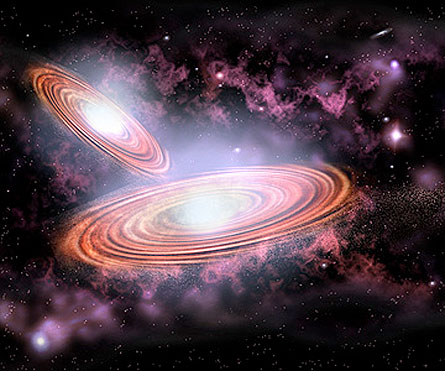Deep-space dancers
In a galaxy far, far away, black holes are spinning around each other
 |
|
A faraway galaxy may have two black holes at its center. The smaller black hole, about the mass of 20 million suns, spins around the larger one, equivalent in weight to 50 million suns.
|
| P. Marenfeld, NOAO |
If you gaze through a telescope at a distant galaxy, it may glow brightly with the light of hundreds of millions of stars. Despite all that light, most scientists think that at the center of a big galaxy lies something very dark: a black hole. A black hole is a region of space with gravity so strong that nothing can escape, not even light.
What’s even stronger than a black hole at the center of a galaxy? Try two black holes, spinning around each other like deep-space dancers.
Astronomers recently announced they have observed a faraway galaxy that may have at its center two black holes, very close together. Todd Boroson and Tod Lauer, the astronomers who have been studying the galaxy, work with the National Optical Astronomy Observatory in Tucson, Arizona.
Based on their observations, the stargazers suspect one of the black holes has more mass than the other. The more mass something has, the stronger its gravitational force, so a larger black hole has a stronger gravitational attraction. This means a larger black hole pulls a smaller black hole toward it. The scientists’ measurements suggest that one of the black holes is as massive as 50 million suns; the other, smaller black hole is about the weight of 20 million suns. The smaller black hole orbits the larger black hole, just as Earth orbits the sun, or the moon orbits Earth.
The two black holes are separated by about 2 million million miles, or one-third of a light-year. That may seem like a long way, but in outer space that’s like standing face to face.
You might think of a black hole as a giant whirlpool in space. If you’re in a spacecraft and you get too close, there’s no way to get out: You just move closer and closer to the black hole’s center. Now try to imagine two whirlpools, the smaller moving around the larger. It may be interesting to see, but steer clear!
The biggest galaxies in the universe form when two smaller galaxies collide. If two galaxies merge, then all of their stars start orbiting a common center. The black holes at the galaxies’ centers should come together, too. Galaxies are colliding all the time, so we should be able to find lots of black hole pairs. But that’s easier said than done — astronomers rarely find these duos in deep space.
To find a black hole — much less two — is complicated. A black hole doesn’t produce any light, so how can you find one in space? Astronomers think that when something (like dust) falls into a giant black hole, a jet of radiation, a form of energy, may stream away. If this radiation is strong enough, it forms a quasar — a bright space object that surrounds the black hole like a shell. By looking at quasars, scientists hope to learn more about black holes.
The Arizona astronomers looked at more than 17,000 quasars and finally found a galaxy that may have a double black hole at its heart. But they’re not sure yet — their research is still unconfirmed, and they may be mistaken. To confirm their suspicions, the scientists will keep taking measurements of the quasar. “This is a candidate, not a proven, binary black hole,” says Lauer.
Power words:
light-year: the distance traveled by light in one year, about 5.9 million million, or 5,900,000,000,000 miles.
black hole: an area in space with a gravitational field so intense that anything nearby gets absorbed — not even light can escape.
quasar: an area around a black hole that can grow as brightly as several trillion suns; A quasar gains energy when something falls into the black hole.
galaxy: A collection of stars, gas, and dust that constitute the universe, containing an average of 100 billion solar masses and ranging in diameter from 1,500 to 300,000 light-years.
Going Deeper:







